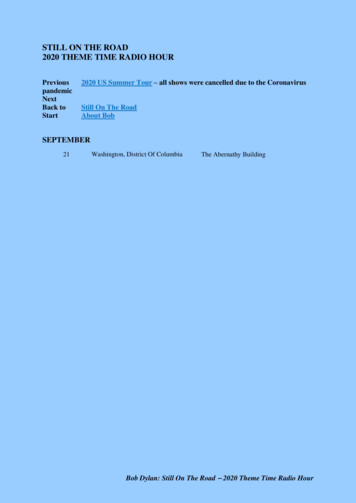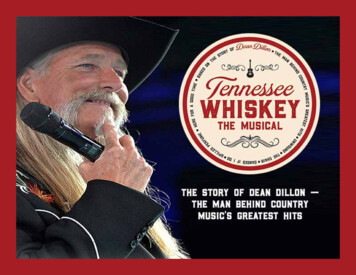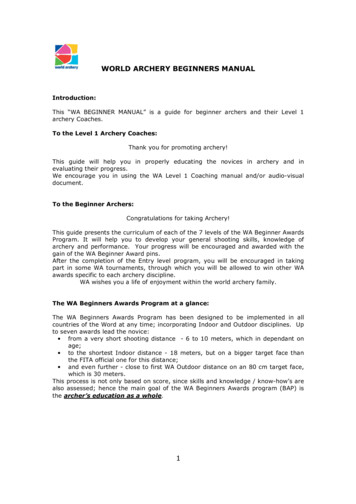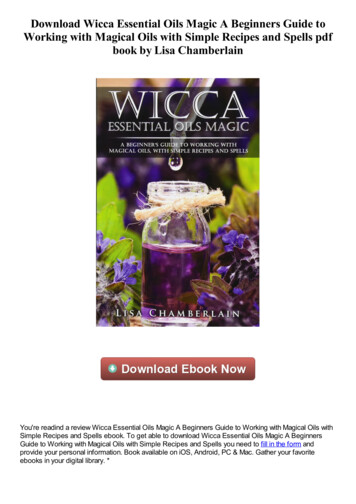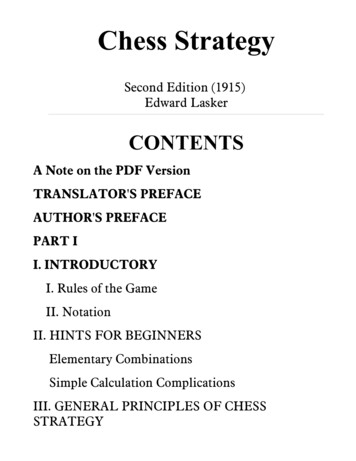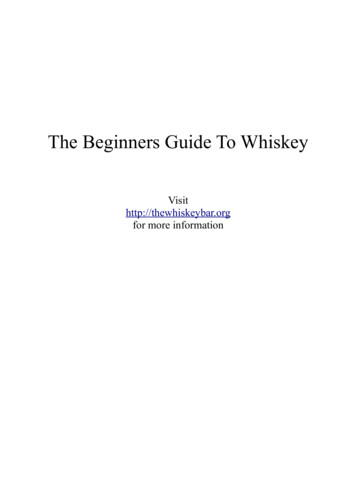
Transcription
The Beginners Guide To WhiskeyVisithttp://thewhiskeybar.orgfor more information
Welcome!Thanks for downloading this e-book. What I had hoped to do with this e-book iscreate a one stop shop document that beginners and intermediate whiskey drinkerscan refer to if they have questions or queries about whiskey.I find whiskey a tremendously interesting and exciting topic and I hope to draw youin with enthusiasm!This e-book contains everything you need to know about whiskies to further yourappreciation of it. A bonus side effect is you will be able to sound smart when talkingabout it at parties.Everything in this document is in short-form and contains only the details you need toknow. You can read this e-book cover to cover or use it as a reference. I recommendreading it cover to cover first and checking out some of the useful links inside, thenreferring back to it later once questions arise.If any questions are unanswered, hit me up by leaving a comment on my website athttp://thewhiskeybar.org or on the Facebook page athttps://www.facebook.com/drinkwhiskyThanks for taking the time to learn more about whiskey!Legal StuffYou may download, print and distribute this document. You are not granted any other permissions regarding the use ofthis file or the contents within it. You may not under any circumstance use the contents of this document on yourwebsite.
What Is Whiskey?Whiskey is a spirit that is distilled from a fermented grain mash. Let's break thatphrase down.Fermentation is when sugars are converted to alcohol via chemical breakdown.Grain is a cereal crop such as barley or corn.Mash is a combination of grains and water.So whiskey is created from a complex process where the sugars in certain grains arebroken down and turned in to alcohol.What is Scotch Whisky? Bourbon? Tennessee Whiskey?All the different types of whiskey can get confusing. The different names depend on anumber of things, including where it is made, what is is made from and how long ithas been aged. Certain types of whiskey must be aged in certain types of barrels aswell – for example, bourbon must be aged in new barrels, whereas Scotch whisky canuse any sort of barrel. Accordingly, Scotch whisky producers buy a lot of old bourbonbarrels in which to age their product Scotch Whisky is whisky made in Scotland that contains malted barley and has been aged at least 3 years in oak casks.Irish Whiskey is whiskey made in Ireland that has been aged at least 3 years inwood casks.Bourbon is whiskey made from a mash that contains at least 51% corn. It isaged in new, charred oak barrels and is mostly made in Kentucky.Tennessee Whiskey is a bourbon whiskey made in Tennessee that is charcoalfiltered. The same rules of bourbon apply to Tennessee whiskey too.Rye Whiskey contains 51% rye (at least in the USA) and is aged in new,charred oak barrels.Canadian Whisky is a whisky that contains some rye and is aged at least 3years.Other areas of the world produce whisky, such as Japan. Yamazaki is an example of agreat 12 year old single malt that tastes like you'd expect a Scotch whisky to taste, butbecause it is not made in Scotland it cannot be a Scotch whisky.Scotland has different whisky production areas. They are Highland, Lowland, Islay,Islands, Speyside and Campbeltown. You can read more about each of the areas here.
Whisky vs WhiskeyWhisky (no E) refers to a product from Scotland or the U.S.Whiskey (with E) refers to a product from Ireland or Canada.Only hardcore whisky enthusiasts will get upset at you if you get it wrong, so don'tworry too much. Most countries not listed above will use the 'whisky' spelling.Age of WhiskeyWhiskey only ages in the barrel. If you buy a bottle of 12 year old whisky, 6 yearslater it is still a 12 year old whisky as it does not age in the bottle.An age statement on the bottle refers to the youngest whiskey in the bottle. A 12 yearold labelled bottle may contain whiskey that is older than 12 years, but may notcontain anything younger. Age can be a good guide on the quality of a whiskey but itis not the be all and end all. Many distilleries are creating excellent whiskies withoutage statements.Other whisky terminology Single malt is a whisky from one distillery only. A blend is a whisky that is made from the produce of a number of differentdistilleries. This is done to create a highly consistent taste and to save money. Cask strength, or barrel-proof, refers to whisky that is not watered down. Caskstrength whiskies are usually around 56% ABV as opposed to around 40%. Peat is a smokey, spicey, salty flavor that comes from smoking the maltedbarley over a fire made from peat (a vegetation found in Scotland). A dram is a colloquial name for a glass of whisky. It's also a unit ofmeasurement, but it's most often just used to describe a pour of whisky. Neat is drinking whisky without water or ice. On the rocks is drinking whiskywith ice.
Appreciating WhiskeyWhisky can be appreciated by anyone, anywhere using any method of consumption.However, if you go to a whisky tasting event or read whisky reviews they refer to anumber of different factors. The colour The nose aka the smell of the whiskey The taste (sometimes called the palate) The finishLet's go in to a bit more detail about each one.1. ColourColour matters least of all. It matters because what we see affects our perception oftaste, so if we see something we like the look of we unconsciously will like the tastebetter. The problem with colour is that in many parts of the world it is perfectly legalto add caramel colouring to whisky, which affects the colour quite a lot. As a result,some reviewers don't bother talking about colour.2. NoseThe nose of the whiskey refers to the aromas that spring forth from it. Smelling awhiskey is referred to as 'nosing' it. It is best done in a nosing glass that taperstowards the top so that all the flavours are captured by your nose. The best glass touse is the Glencairn glass. If you don't have one and don't want to buy one, you canuse a wine glass with a small opening.To nose the whiskey, simply bring the top of the glass right up to your nose and take anice big breath in.
3. TasteWhat flavours are present in the whiskey. People also talk about the “body” or“mouth feel” of the whiskey, which is essentially what it feels like in the mouth.To taste a whisky, have a sip and move it all around your mouth. The best way to dothis is to literally try and chew the whiskey as you would a big mouthful of food.Each area of your mouth might experience a different flavour so it's important tospend a bit of time on it.Note: it's considered to be okay to add a few small drops of water when tastingwhiskey, but not ice. Ice cools the whisky which prevents appreciation of someflavours and also excessively dilutes it. If you're just starting out you might want toadd ice anyway to 'soften the blow' a bit. Adding coke to whiskey is not a crime, butit better be Johnny Walker Red Label and not a beautiful single malt.4. FinishThe finish is what happens after you swallow the whiskey. This can be both in taste,freshness and length. Read the section below for more details on how to describe thefinish.
Describing WhiskeyThe words that we use to describe whiskey are the flavours that we can detect inthem. What flavours you experience will depend on lots of factors, including yourexperiences with the flavours and how many whiskies you have tasted. It can beuseful to read some reviews of a whiskey before tasting it and see if you canexperience the flavours that the reviewers are describing.Here are some examples of common flavours:oak, chocolate, citrus, sherry, floral, vanilla, cereal, malt, earth, dried fruit, cookedfruit, ripe fruit, nut, leather, smoke, salt, brine, medicine, fish.These can be experienced in both nosing and tasting. You can go in to more detail ifyou want, such as almonds instead of nutty and cough syrup instead of medicinal.Sometimes you might detect a flavour when nosing but not in the tasting and viceversa. The words you use to describe the whiskey are totally up to you and there areno correct terms to use.When describing a finish, people talk about length. Remember that the finish is theeffect after swallowing. Sometimes the taste or feeling hangs around for ages, andthis is a long finish. Sometimes it goes in seconds, and this is a short finish. A finishcan also be warm, powerful, smooth or any other words that you can use to describeyour feelings after swallowing the whiskey.
Recommended Whiskies for Beginners (or anyone looking for a daily drinker)Blends: Johnnie Walker Black Label, Chivas Regal, JamesonScotch Whisky: Highland Park 12, Ardbeg 10, Glenfiddich 18Irish Whiskey: Redbreast 12, Bushmills 10
Rye Whiskey: Sazerac Rye, Knob Creek RyeBourbon: Wild Turkey 101, Buffalo Trace, Old Grand-Dad (100 or 114)
ConclusionWell, that's more than enough information to get you started on your whiskey tastingadventures. Perhaps you are still at the stage where you find it difficult to drinkwhiskey neat – keep sipping away and developing your taste for it. You may recallthe first time you had wine or coffee as being quite unpleasant, but over time youdeveloped a taste for it. The same is true for whiskey. Once you are able to enjoywhisky neat a whole new world of exciting flavours opens up.Here's to good drinking times in the future. See you online at http://thewhiskeybar.orgCheers!Lawrie
What Is Whiskey? Whiskey is a spirit that is distilled from a fermented grain mash. Let's break that phrase down. Fermentation is when sugars are converted to alcohol via chemical breakdown. Grain is a cereal crop such as barley or corn. Mash is a combination of grains and water. So whiskey is created from
